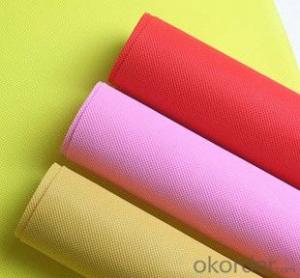Colorful PP Spunbonded Nonwoven Fabric NW12 Geotextile
- Loading Port:
- China Main Port
- Payment Terms:
- TT OR LC
- Min Order Qty:
- -
- Supply Capability:
- -
OKorder Service Pledge
OKorder Financial Service
You Might Also Like
Introduction of polypropylene spunbond non woven fleece fabric is used to protect the crops in agriculture UV resistance masterbatch could be added 1%~8%. It can protect the vegetable crops and new lawns against extreme weather, animal and insect damage, yet allows light, water and air to penetrate, creating protected growing conditions..
Specification of Polypropylene Spunbond Non Woven Fabric:
100% Polypropylene/100% PP
Color:Any color can be available
GSM(gram per square meter): 9-180GSM
Roll Width 4-320cm
Roll Length According to your requirement
Technics Nonwoven Spunbonded
Feature Waterproof, Mothproof, Eco-friendly, Non-toxic, Breathable, Anti-Bacteria
Packing of Polypropylene Spunbond Non Woven Fabric:
Each roll is wrapped in a plastic bag with label specification with paper tube inside .
- Q: What are the key considerations for geotextile installation in high water flow areas?
- The key considerations for geotextile installation in high water flow areas include selecting a geotextile with the appropriate filtration and hydraulic properties, ensuring proper anchoring and securing of the geotextile to prevent movement or displacement, maintaining proper overlap and seam integrity to maximize effectiveness, and considering factors such as soil conditions, potential erosion, and durability of the geotextile in high flow conditions.
- Q: How do geotextiles help with load support in unpaved roads?
- Geotextiles help with load support in unpaved roads by providing a stable base and preventing the mixing of different soil layers. They act as a barrier between the road surface and the underlying soil, distributing the load evenly and reducing the risk of rutting and deformation. Additionally, geotextiles enhance the drainage capabilities of the road, improving its overall strength and durability.
- Q: Geotextile 0.2 and 1.0 which is more sunscreen
- Certainly the thicker the more sun, and I professional production geotextile geomembrane, wish smooth
- Q: What are the maintenance requirements for geotextile-reinforced retaining walls?
- The maintenance requirements for geotextile-reinforced retaining walls typically include regular inspections for signs of erosion, damage, or structural issues. Additionally, any vegetation growing near the wall should be monitored and removed if it poses a threat to the integrity of the structure. It is also important to ensure proper drainage and prevent water buildup behind the wall. Regular cleaning and removal of debris is necessary to avoid blockages and maintain the functionality of the drainage system. Overall, following manufacturer guidelines and conducting routine maintenance activities will help ensure the longevity and effectiveness of geotextile-reinforced retaining walls.
- Q: You produce 700 grams of high-strength polypropylene geotextile it?
- 700 grams of high-strength polypropylene geotextile is designed for high-speed rail sliding layer of high-strength wear-resistant geotextile, our products in the West high-speed rail passenger line, OKorder and Hangzhou and other high-speed rail lines have applications.
- Q: what is the function of geotextiles in footing any photos?
- tis like the subway put some liver in ur mouth In the middle of rush hour whore some year old mayonnaise meets yesterdays tuna It’s end of line.!!!!!!!!
- Q: What are the different geotextile weight classes and their applications?
- Geotextile weight classes range from light to heavy, with each class having specific applications. Lightweight geotextiles are typically used for erosion control, landscape projects, and separation of materials. Medium weight geotextiles are commonly used for filtration, drainage, and reinforcement purposes. Heavyweight geotextiles are suitable for projects that require strong stabilization, such as road construction, embankment reinforcement, and landfill capping.
- Q: What are the benefits of using geotextiles in road construction?
- Geotextiles offer several benefits in road construction. Firstly, they enhance the stability and durability of the road by acting as a reinforcement layer, distributing loads and preventing the mixing of different layers. Secondly, geotextiles improve drainage by allowing water to pass through, reducing the risk of water damage and prolonging the life of the road. Additionally, they help control soil erosion and prevent the loss of fine particles, which can lead to the formation of potholes and cracks. Overall, geotextiles contribute to cost-effective and sustainable road construction, increasing the lifespan and performance of the road infrastructure.
- Q: JTGF80 / 1-2004 "standard" 4.5 Geosynthetics in the treatment of the measured items in the "anchoring length", in the construction design diagram, the provisions of the value of the allowable deviation should be how to implement? Question added: Sorry! I missed a few words. When the construction design is not indicated, the specified value, the allowable deviation value should be implemented? JTGF80 / 1-2004 "standard only write to meet the design, construction requirements. I did not say that the design of the length of the anchorage is how much, can not find the construction technical specifications. So I do not know the provisions of the value of how to allow deviation? More
- Specifically not less than the specified value, does not exceed the allowable deviation. This is the so-called construction by specification! You refer to JTG assessment standard -2004 is correct! I have the data to let you refer to the next / geogrid and geotextile landscape is greater than or equal to 50cm, vertical is greater than or equal to 150com
Send your message to us
Colorful PP Spunbonded Nonwoven Fabric NW12 Geotextile
- Loading Port:
- China Main Port
- Payment Terms:
- TT OR LC
- Min Order Qty:
- -
- Supply Capability:
- -
OKorder Service Pledge
OKorder Financial Service
Similar products
Hot products
Hot Searches
Related keywords
























